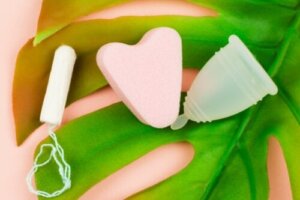Advantages and Disadvantages of Menstrual Sponges


Reviewed and approved by the nurse Leidy Mora Molina
Menstrual sponges are a sustainable feminine hygiene item that has all the characteristics to replace single-use tampons or menstrual cups. It is a safe and effective internal retention method.
Estimates indicate that the average woman uses up to 9,000 pads and tampons during her fertile life. These plastic items take up to 300 years to degrade. Thus, menstrual sponges are a much more sustainable option.
Menstrual sponges or sanitary sponges or sponge tampons aren’t common, despite their advantages. However, they are not a new product, as women have been using them since ancient times. Let’s see what they are and what their benefits and disadvantages are.
What are menstrual sponges

Menstrual sponges are a feminine hygiene product similar to a tampon. You place them inside the vaginal canal to absorb menstrual bleeding for about six to eight hours. Furthermore, you can reuse them; their useful life is approximately one year.
These types of elements are very flexible and this allows them to adapt perfectly to the walls of the vagina. Menstrual sponges can be of two types: natural or synthetic. The natural ones are of marine origin, biodegradable and reusable. Don’t reuse synthetic sponges.
Natural menstrual sponges have been around for about 3,000 years. However, women didn’t use them much. Some women discovered them in the 19th century, but fell into oblivion in the 20th century. Today, they are once again an alternative for intimate hygiene.
Marine sponges are cultivated or collected from the ocean. Their base is not touched so that the organism can regenerate. They are harvested only when they have reached more than 12 and a half centimeters. They are marketed with hardly any major changes.
Use of menstrual sponges
The use of menstrual sponges is very simple. First, it is well moistened and then wrung out to remove excess water. Then, it is folded and inserted into the vagina, pushing it with the fingers, with a gentle movement. It should go all the way in and not cause any discomfort.
Although it can be used for up to eight hours, it is usually used for between three and six hours. It all depends on the amount of bleeding. While wearing it, it is possible to perform any activity without leaking.
These sponges sometimes come with a grip tape. To remove them, simply pull the tape gently. Another possibility is to squat down, insert the fingers into the vagina and remove it. If there is any difficulty, the best thing to do is to get under the shower and wet the entrance of the vagina. This causes the sponge to swell and lower, making it easier to remove.
The advantages of menstrual sponges
One of the great advantages of natural menstrual sponges is that they are 100% ecological and recyclable products. In addition, you can trim them to better fit each woman’s body, making them very comfortable.
These sponges are soft and free of many toxins. Pads and tampons usually have materials with some petrochemical derivative. They are also hypoallergenic and antibacterial. Therefore, there will be no irritation, itching or discomfort.
In addition to everything, they are suitable for any woman, even if she has some kind of genital prolapse. They are also comfortable when having sex and have a shelf life of up to one year, although it’s best to discard them after six months.
Synthetic menstrual sponges do not have as many advantages, especially from an ecological point of view. However, they are as ergonomic as natural sponges and have designs that make them easier to insert and remove.
Read Mindful Menstruation: Why Is It Important to Know Your Cycle?
The disadvantages of menstrual sponges
Among the drawbacks of natural menstrual sponges is the fact that they are somewhat rough. If you don’t moisten them, they can cause some discomfort when you put them in. In addition, only the synthetic ones have a grip system that facilitates removal.
However, the biggest problem would be in the hygienic aspects. It is very important to purchase this type of product from a reliable supplier. It is possible that in their natural state they still have sand or some residue of elements present in the sea.
Also, washing menstrual sponges before reuse can be complex. Thus, some debris and microorganisms may remain on them. This could favor bacterial overgrowth and lead to infection. At the moment, there is not enough research on this.
Some tips and facts

Ideally, you should buy brown menstrual sponges, as the yellowish ones may be of lower quality. It is not advisable to wash them with soaps or detergents during menstruation. The best thing to do is to clean them with plenty of water and use them again.
Outside menstruation, it is best to soak them overnight in a preparation with water, baking soda, and apple cider vinegar. The next day, wash them very well until they are completely clean.
Then, drain them and let them dry in the air, preferably hanging them with a clothespin or string. Once they are dry, store them in a clean bag, ideally made of cotton. If they fall apart or loose dust, throw them away. The general recommendation is to throw them away after six months.
Consult your gynecologist
It is best to buy menstrual sponges in pharmacies or specialized stores. If you notice any changes or unpleasant symptoms when you start using them, it is best to stop using them and consult your gynecologist.
At the moment, no brand of menstrual sponge has approval from the US Food and Drug Administration (FDA). If there is any doubt about their use or purchase, it is best to consult a physician.
All cited sources were thoroughly reviewed by our team to ensure their quality, reliability, currency, and validity. The bibliography of this article was considered reliable and of academic or scientific accuracy.
- Rodríguez Rueda, C. A. (2018). Sens una alternativa para la retención del flujo menstrual.
- Ann Intern Med. 1982 Jun;96(6 Pt 2):948-51. Bacterial flora of the vagina during the menstrual cycle: findings in users of tampons, napkins, and sea sponges. doi: 10.7326/0003-4819-96-6-948.
- FDA. Center for Devices and Radiological Health. Office of Regulatory Affairs. CPG Sec. 345.300 Menstrual Sponges. https://www.fda.gov/regulatory-information/search-fda-guidance-documents/cpg-sec-345300-menstrual-sponges
This text is provided for informational purposes only and does not replace consultation with a professional. If in doubt, consult your specialist.








